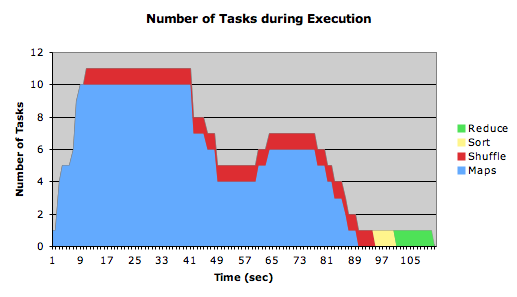Difference between revisions of "CSC352 Homework 4"
(→Parsing XML Files) |
(→Parsing XML Files) |
||
| Line 79: | Line 79: | ||
Parsing XML files can be done using a special input reader, according to the Apache Hadoop 0.19 [http://hadoop.apache.org/common/docs/r0.19.2/streaming.html#How+do+I+parse+XML+documents+using+streaming%3F documentation]: | Parsing XML files can be done using a special input reader, according to the Apache Hadoop 0.19 [http://hadoop.apache.org/common/docs/r0.19.2/streaming.html#How+do+I+parse+XML+documents+using+streaming%3F documentation]: | ||
| + | <tanbox> | ||
;How do I parse XML documents using streaming? | ;How do I parse XML documents using streaming? | ||
:You can use the record reader StreamXmlRecordReader to process XML documents. | :You can use the record reader StreamXmlRecordReader to process XML documents. | ||
| Line 84: | Line 85: | ||
:<tt>hadoop jar hadoop-streaming.jar -inputreader "StreamXmlRecord,begin=BEGIN_STRING,end=END_STRING" </tt>..... (rest of the command) | :<tt>hadoop jar hadoop-streaming.jar -inputreader "StreamXmlRecord,begin=BEGIN_STRING,end=END_STRING" </tt>..... (rest of the command) | ||
Anything found between BEGIN_STRING and END_STRING would be treated as one record for map tasks. | Anything found between BEGIN_STRING and END_STRING would be treated as one record for map tasks. | ||
| + | |||
| + | </tanbox> | ||
===Submission=== | ===Submission=== | ||
Revision as of 21:45, 11 April 2010
This homework is due 4/20/10, at midnight.
Contents
Problem #1: Timelines
Below is the timeline of the WordCount program running on 4 xml files of 180 MB each on a cluster of 6 single-core Linux servers. (data available here). The files are in the HDFS our the Smith College Hadoop cluster, in wikipages/block.
- Question
- Explain the camel back of the time line, in particular the dip in the middle of the Map tasks. Note that this is not an artifact of unsynchronized clocks. The server clocks had been synchronized before the experiment.
Submission
Submit your answer as a pdf from your 352b beowulf account, please.
submit hw4 hw4a.pdf
Problem #2: Counting Unique Categories
Write a Map/Reduce program that reports the number of unique categories and the number of times they appear in wikipages/00/00 on the HDFS. wikipages/00/00 contains 591 individual wikipages in xml.
Measure the execution time of your program and report it in the header of your program.
- Optional and Extra Credit
- Same question for the categories in wikipages/block/all_00.xml, which contains all the wikipages with the Ids of the form x...x00xx. all_00.xml contains 117,617 individual wiki pages.
You are free to write in Java or use streaming and program in Python or some other language of your choice. If you are using Python, check Michael Noll's tutorial for a way to improve the reading of stdin information for the map and for reduce functions.
- Question 1
- Report the execution time of your program(s) in the header.
- Question 2
- Even if you do not attempt the extra-credit option, think about this observation and report your answer: Could there be a problem with the exactness of the result when a MapReduce program processes the file all_00.xml. Reading Module 5 of the Yahoo Tutorial might help you answer the question. Report the answer in the header of your program(s).
- Note
- The 5 million wikipedia files are available on the local disk of hadoop6, which, unlike the other servers in our cluster contains only one OS, Ubuntu, which takes over the whole local disk, and offers us the server with the biggest local storage.
Submission
Submit your program(s) as above:
submit hw4 hw4b_yourprogram submit hw4 hw4b_yourotherprogram
Problem #3: Counting Most Frequent Words
Write a Map/Reduce program that reports the five most frequent words in each page, and the number of times they occur in all the pages processed. They should not include stop-words.
You are free to write in Java or use streaming and program in Python or some other language of your choice.
You are free to report a list of counters, or a single counter for each word. For example, if Buck appears as one of the 5 most frequent words in 3 pages, and if its frequency is 10 in the first page, 20 in the second, and 30 in the third, then your result could be either
Buck: 10, 20, 30
or
Buck: 60
Use the format that will make your life easier in the final project.
Details
File Name
In order to find the most frequent words in a file, you will likely need to access the name of the input file from within the map function. The solution to inverted index code in the Yahoo Tutorial, Module 4 indicates that this can be done with this Java code:
FileSplit fileSplit = (FileSplit)reporter.getInputSplit();
String fileName = fileSplit.getPath().getName();
Parsing XML Files
Parsing XML files can be done using a special input reader, according to the Apache Hadoop 0.19 documentation:
- How do I parse XML documents using streaming?
- You can use the record reader StreamXmlRecordReader to process XML documents.
- hadoop jar hadoop-streaming.jar -inputreader "StreamXmlRecord,begin=BEGIN_STRING,end=END_STRING" ..... (rest of the command)
Anything found between BEGIN_STRING and END_STRING would be treated as one record for map tasks.
Submission
Include a sample of the output of your program in its header, and submit it as follows:
submit hw4 hw4c_yourprogramname
